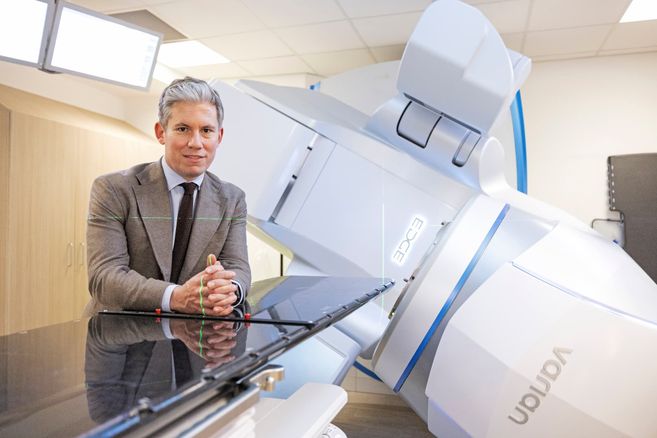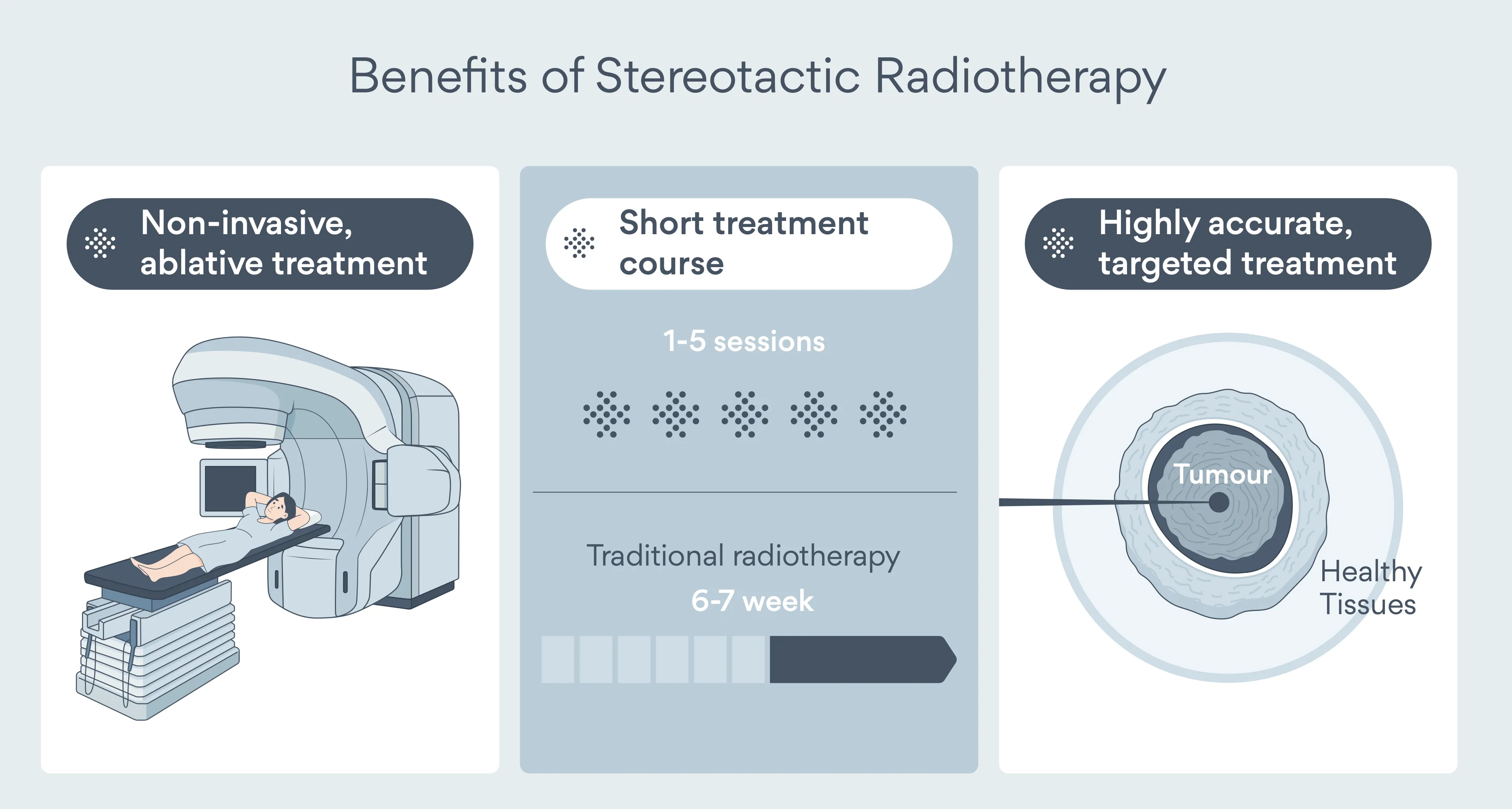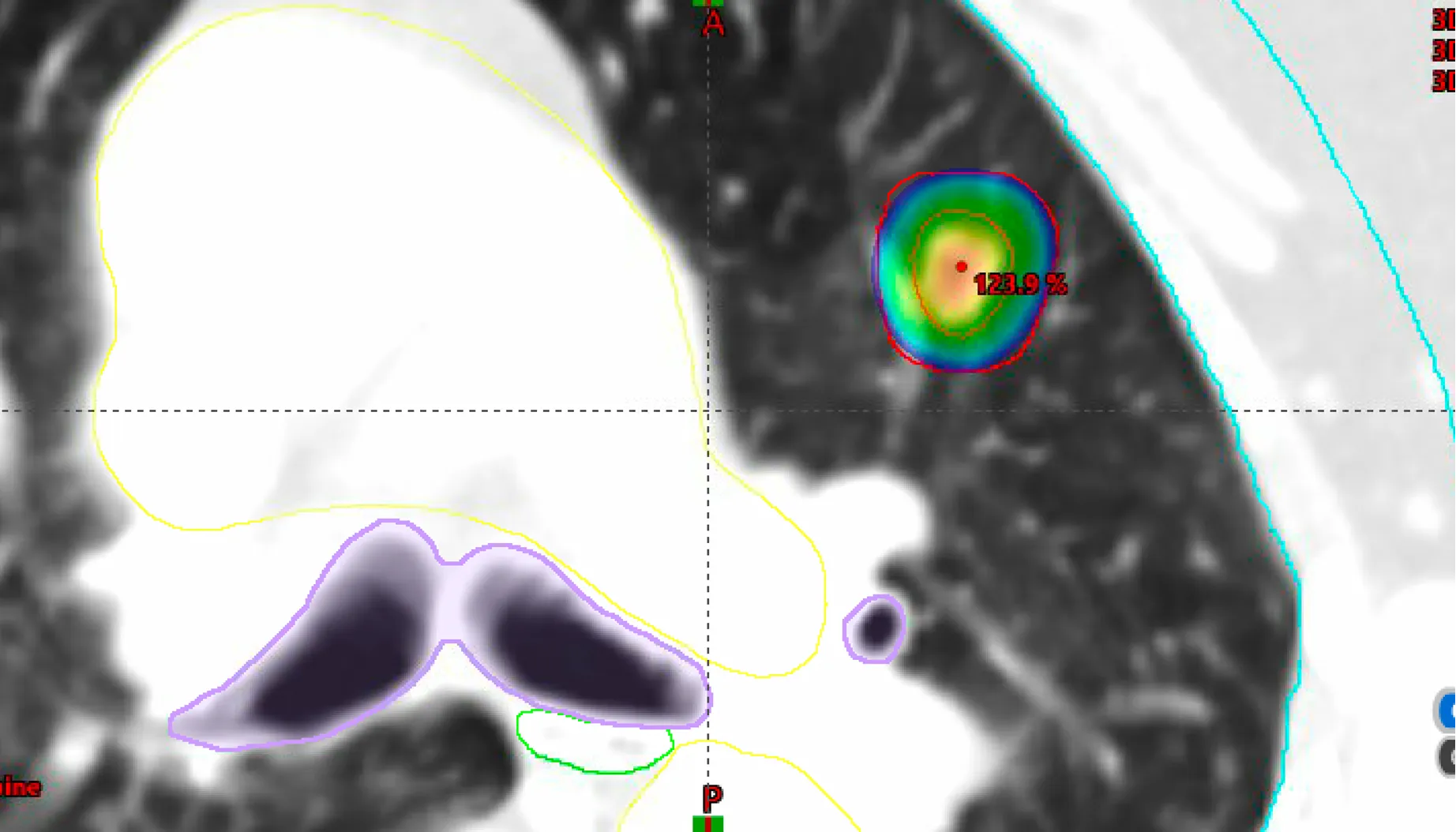Stereotactic Radiotherapy for Lung Cancer: Expert Care in London
Discover how stereotactic radiotherapy delivers high-dose precision treatment for lung cancer and other tumours. Dr James Wilson offers SABR and CyberKnife at leading London hospitals. Book your personalised consultation today.


Stereotactic Radiotherapy for Lung Cancer: Expert Care in London
What is Stereotactic Radiotherapy?
Stereotactic Ablative Radiotherapy (SABR), also known as Stereotactic Body Radiation Therapy (SBRT), is a highly advanced and non-invasive form of radiotherapy that delivers high doses of radiation to tumours with exceptional precision. It uses a radiotherapy machine to treat cancer in different parts of the body, including lung cancer, brain tumours, spine, lymph nodes, and soft tissue lesions.
Unlike conventional radiotherapy, SABR uses advanced imaging techniques like CT scans, MRI scans, and PET scans to pinpoint the tumour’s location. This enables radiation oncologists to direct radiation beams from different angles to a small area, reducing harm to surrounding healthy tissue.
Because of SABR's incredible accuracy, we can treat even small tumours with precision and accuracy to make sure all cancer cells are effective treated.
With SABR, the radiation dose is concentrated on the tumour, enabling treatments ranging from a single treatment to a maximum of eight treatment sessions, instead of daily treatments for six weeks or more. This means fewer hospital visits and fewer side effects.
"My personal cure rate is 90% when using SABR to treat patients with early-stage lung cancer." — Dr James Wilson
How It Differs from Traditional Radiotherapy
Stereotactic body radiotherapy differs from traditional radiotherapy by delivering a much higher dose in fewer sessions, focused precisely on the tumour. Traditional radiotherapy usually requires 20–30 sessions and treats a broader area, affecting nearby healthy tissue.
Stereotactic ablative body radiotherapy is a type of radiotherapy that reduces the risk of side effects, shortens the overall treatment time, and is often more effective for patients with early-stage, small, or inoperable tumours.
Benefits of Stereotactic Radiotherapy
High Precision and Accuracy

Advanced imaging and planning scans enable millimetre-level targeting. Devices like the radiotherapy mask, head frame, and small metal markers for some patients help ensure the tumour is in the correct position throughout treatment.
Reduced Side Effects
Because SABR targets only the tumour and spares healthy brain tissue, soft tissue, and other nearby organs, it significantly reduces the risk of side effects compared to external beam radiotherapy. As the normal lung tissue and oesophagus receive a much lower dose than with standard radiotherapy, my patients experience far fewer side effects.
Fewer Treatment Sessions
SABR allows for a short treatment course, often requiring just one to five sessions on the treatment couch. This is ideal for patients with mobility issues, busy schedules, or those travelling from outside London.
Applications of Stereotactic Radiotherapy
Lung Cancer (SABR)
SABR is a transformative treatment for early-stage non-small cell lung cancer and small cell lung cancer. It provides a high dose of radiation to the lung tumour with high precision, offering patients a non-invasive alternative to surgery for any cancer type.
Your suitability for SABR for lung cancer depends on the stage of your cancer. See the lung cancer guide for more information, but the stage is decided on factors such as the size of the tumour and if it has spread to the lymph nodes or other sites.
If your tumour is near the chest wall, spine, blood vessels, the heart or main airways, or if you’ve been told surgery isn’t an option, SABR may still be effective. Using CyberKnife, MR-Linac, or linear accelerators (Linacs), Dr Wilson treats tumours that other centres may avoid.

Brain Tumours (SRS)
Stereotactic radiosurgery (SRS) is used to treat brain cancers, including brain metastases, acoustic neuroma, vestibular schwannoma, pituitary gland tumours, and even non-cancerous conditions like trigeminal neuralgia and Arteriovenous Malformations (AVM).
Radiosurgery treatment for brain metastasis (secondary brain tumours) has an excellent change of eliminating the sites of disease in the brain. If you require treatment for a large number of brain metastases and the CyberKnife treatment takes a long time, we will plan short breaks during the treatment.
Other Cancers (Spine, Liver)
SABR also treats cancers in the spine, liver, and adrenal glands, particularly in patients with oligometastatic or oligoprogressive disease — where only a few areas of cancer spread are active.
The Treatment Process
Initial Consultation
In your first consultation — either in person or online — Dr Wilson will discuss your cancer diagnosis, review your scans and test results, and explain your treatment options. You’re welcome to bring a loved one for support.
Time is of the essence, especially in lung cancer care, so treatment planning begins promptly. Dr Wilson will personally oversee your care and ensure all decisions are clear and collaborative.
Planning and Simulation
You'll undergo planning scans using MRI (magnetic resonance imaging), CT (computed tomography), or PET (positron emission tomography) to design your treatment plan. Devices such as a radiotherapy mask or head frame (if having GammsKnife for brain metastases) may be required to ensure accurate targeting, but not in every case.
A great deal of expertise is accessed through the whole treatment team to ensure your personalised radiotherapy plan is accurate to maximise effectiveness. There is a dialogue between your oncologist and medical physicist to refine your precision cancer treatment.
Treatment Delivery
When your treatment starts, it takes place on a radiotherapy couch in a specially designed treatment room. Radiographers (Radiation therapist) will get you in the right position on the treatment couch before taking scans to ensure accuracy. Stereotactic radiotherapy treatments are then delivered using advanced technology, including:
-
CyberKnife (robotic precision)
-
Varian Edge (real-time tumour tracking)
-
TrueBeam (multi-angle beam delivery)
-
MR-Linac (live MRI guidance during treatment)
Treatment is typically painless and non-invasive, with most sessions lasting 30–90 minutes.
Follow-Up Care
Dr Wilson and the radiotherapy team, including clinical nurse specialists, physiotherapists, and dieticians, provide comprehensive follow-up. Regular scans assess progress, and support is available for any symptoms or concerns.
Dr. James Wilson: Your Expert in Stereotactic Radiotherapy
Why Choose Dr. Wilson?
Dr James Wilson is a leading Consultant Clinical Oncologist with advanced training in Radiation Oncology. He specialises in SABR, CyberKnife, MR-Linac, and other targeted cancer treatments for complex and inoperable cases. In selected cases, he offers proton beam therapy and has access to the most up-to-date Linac machines.
“SABR is an exciting advancement in cancer treatment in the UK. I’m proud to be one of the few consultant oncologists able to offer the latest stereotactic technologies to patients.” — Dr James Wilson
Advanced Training and Credentials
-
MBBS (Hons with Distinction)
-
DPhil (PhD from the University of Oxford)
-
Member of the Royal College of Physicians
-
Fellow of the Royal College of Radiologists
-
Trained at Royal Marsden Hospital and Massachusetts General Hospital
High Success Rates
Dr Wilson’s personal SABR cure rate for early-stage lung cancer is 90%. He also treats patients with metastatic disease or those seeking a second opinion.
Cutting-Edge Technologies
-
CyberKnife: Robotic, frameless delivery
-
MR-Linac: MRI-guided radiation in real time
-
Varian Edge and TrueBeam: Dynamic tumour tracking
Personalised Care
You’ll receive a tailored treatment plan with 24-hour access to clinical support, options for nearby accommodation, and regular follow-up with Dr Wilson and his trusted team of healthcare professionals.
Patient Success Stories
Mrs CJ – “SABR Gave Me Back My Time”
After being diagnosed with early-stage lung cancer, Mrs CJ chose SABR to avoid surgery and hospital stays. Her treatment was scheduled around school runs and she returned to normal life quickly.
Mr MP – “From Pain to Playing Golf Again”
With advanced lung cancer that had spread to his hip, Mr MP received three SABR sessions. Within weeks, his pain reduced dramatically, and he returned to his favourite hobby.
Virtual Consultations for UK-Wide Access
Patients across the UK can benefit from Dr Wilson’s expertise via video consultations. These sessions are ideal for:
-
Exploring treatment options
-
Discussing clinical trials
-
Obtaining a second opinion
Dr Wilson can also help arrange accommodation near his London-based clinics.
Potential Side Effects and Risks
Common Side Effects
-
Fatigue
-
Skin redness or itchiness
-
Mild discomfort or chest pain
-
Hair loss (rare, usually only with brain tumour treatment)
Managing Side Effects
Dr Wilson’s health care team provides expert support for possible side effects, but also including emotional support, symptom management, and follow-up with your GP or local team. Most side effects are temporary and manageable.
Frequently Asked Questions
Is stereotactic radiotherapy painful?
No. Treatment is painless. Some patients experience temporary fatigue or discomfort afterwards. We'll talk about the possible side effects before treatment starts as it depends on the part of the body that is being treated.
How long does treatment take?
Sessions can last 15–90 minutes depending on the treatment area and number of fractions. Some cases are completed in one visit.
What cancers can it treat?
SABR and stereotactic radiosurgery can treat lung cancer, brain tumours, prostate cancer, spinal lesions, secondary liver cancer, adrenal metastases and more.
How does your clinical approach differ?
Dr Wilson uses advanced imaging, offers access to clinical trials, and personalises care using the latest international guidelines from Cancer Research UK, the National Cancer Institute, and the American Cancer Society.
Are there clinical trials available?
Yes. Dr Wilson offers access to UK-based clinical trials and will discuss their suitability with you.
Contact Dr. James Wilson
Book a Consultation
-
Email address: info@drjameswilson.co.uk
-
Phone: +44 (0)20 7993 6716
-
Website: drjameswilson.co.uk/contact
-
Direct bookings: Click here
For health professionals - please use the above number to arrange a time for us to speak, or you can refer electronically by clicking here.
Virtual Consultations
Video appointments are available for patients across the UK.
For more patient information, please visit the 'Articles' section of this site.